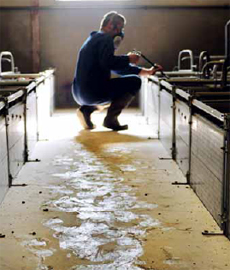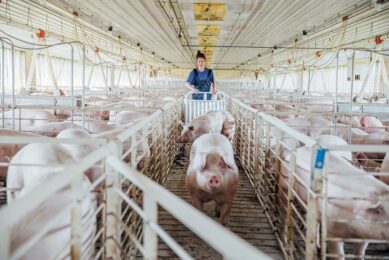Even healthy pigs can give producers a headache

In many countries, pig health and pig welfare have been important topics, but pig producers themselves tend to get less attention. Nevertheless, respiratory problems among swine producers appear to be a fairly common phenomenon – and they can strike worldwide. There are ways to prevent these.
By Vincent ter Beek
In his own words, Jos Rooijackers’ biggest concern is that pig producers are caught in the middle. “They have
many physical symptoms but once they are screened by doctors, nothing can be found. Hence, health insurance companies are not willing to pay. That, for me, was very important to join initiatives to ask for more attention to be paid to this problem.”
Rooijackers, age 50, is a Dutch chest physician, working at the Netherlands Expertise Centre for Occupational Respiratory Disorders (Necord), located in the city of Utrecht. As his full focus is work-related lung diseases in humans, he has a bridge function between the day-to-day practice and the academic world of lung research.
Rooijackers explains that in agriculture and related occupations lung problems are fairly common, for instance poultry producers (feathers) or bakers (meal) have been known to develop lung disease symptoms. Swine producers also belong to this group, although he feels the topic remains somewhat uncovered. “I have been invited to a meeting of a Dutch parliamentary commission evaluating animal welfare,” he explains, “and it is wonderful to see how many initiatives have been developed to guarantee pig welfare. But what about the producers themselves?”Many pig producers are known to have developed respiratory-disease related symptoms, earlier studies indicate the percentage is between 10-30%. Symptoms may vary from occasional difficulty with breathing when being inside a pig operation to heavy coughing, shivering, transpiration, aching joints and fever which continue long after a producer has left a swine house.
Network group
Rooijackers was involved in setting up a Dutch network group around the problem, in which swine producers, health professionals and authorities could share experiences and find solutions – and ask for more awareness among producers. One of the first steps to get there was by launching a questionnaire at national Dutch livestock shows, in which producers were asked to give information about their perception of their own lung health, to get a better idea of the size of the problem.
Rooijackers says, “Most pig producers suffering from respiratory problems, actually do acknowledge this fact. And they also know that something needs be done about it. But how – they don’t know.”
Lung problems can be created by several different causes, each of which can be called ‘irritants’. Often, correct detection of the exact cause is difficult as symptoms occur in combinations, varying from person to person in severity and clinical signs. Rooijackers says, “First, there is dust and skin particles. These can be shedded by pigs or poultry themselves, but can also come from straw or from animal feed. Secondly, ammonia has a strong effect on the lungs. Thirdly, there are endotoxines – these are toxins created by bacteria and fungi. In high concentrations, these can be toxic for humans.”
“Last but not least, I’d like to mention the Methycillin Resistant Staphylococcus Aureus (MRSA) bacteria, which
has been proven to exist in pig populations. It can also cause disease in humans and has been shown to jump from pigs to humans.”
Symptoms can be only incidental – but could also become chronic. In the worst case, symptoms may not even disappear at all – and producers may even suffer when being in the fresh air. For instance, among pigeon breeders, hypersensitivity pneumonitis and lung fibrosis is a well-known effect, occurring due to a permanent exposure to feathers and excretions. Hay can have the same effect on certain farmers. Rooijackers further mentions ‘Organic Dust Toxic Syndrome’ (ODTS), in which he copied down clinical signs as nausea, shortness of breath, myalgia and coughing.
He emphasises that for insurance matters, the division between ‘harmful’ and ‘bothersome’ is a fine line. Since most symptoms often disappear once producers are in fresh air, symptoms are simply classified as ‘bothersome’. “Often, producers get the impression that insurance companies do not believe them if they suffer from certain symptoms.”
Solutions
The other side of the coin, however, is that these symptoms can lead to something worse. This is the reason why Rooijackers feels that more attention needs to be given to the problem. The network group, for this reason, has launched a lobby in governmental circles to ask that more attention be paid to the problem.
In the meantime, producers themselves can do something to make their life easier. Individual protection is a relatively simple solution (see Box Practical example: Erik Ordelman). In addition, taking care of a more healthy and natural ventilation system is another. Rooijackers says, “Recently, more attention towards air cleaning systems has been asked for, to make sure the environment does not suffer from bad odours. No-one however, so far, has asked any questions about the air quality inside the barns.” Wageningen University and Research Centre is working to fill that gap and hopes to find solutions in this direction (see Box Research on (biological) farms).
Practical example: Erik Ordelman Pig farmer Erik Ordelman, age 40, located in the village of Kilder, the Netherlands, has a 400 sow breeding farm, with an additional 350 sows at an external location. He hopes to grow at the Kilder site to 1,000 sows. Ordelman has been involved in pig farming since he was young. “I have been inside pig houses since I was 14 years old. At the time, it was only for one or two hours, but I always had difficulty with breathing. When I left school, I started working at a pig farm full-time. I noticed I continued to have breathing troubles. I suffered from coughing and irritated mucosa in my upper lung system. Often, after one or two hours in the fresh air, all symptoms were gone again.” In order to fight his lung problems, Ordelman quit smoking, but this did not improve the situation. It turned out he is hypersensitive to both ammonia and dust particles. Ever since he has known this, he has been wearing a mask (see photo) inside the pig house. He indicates the mask really helps him breathe normally. It consists of a package with two tubes, consisting of a carbon filters. These need changing regularly; a mask can be used for 1.5 to two years. He wears the mask 30-40 hours/week. Ordelman joined the networking group as he was interested to participate. “I cannot say the lung problems did not allow me to work. It was just a nuisance. But since it’s been there forever, I had simply accepted it and used to think it was part of the deal.” Ordelman weans on average 27 piglets per sow per year. His piglets are being sold to finishing farms on the market at day 55, when they weigh 25 kg. The piglets are fed dry pelletised feed, which includes a wide variety of ingredients. As for the sows on his farm, they are the only animals to be vaccinated: they receive shots for PRRS, Swine Influenza, E.coli and parvovirus. According to future EU legislation, dry sows are group housed using free access stalls. They are fed a mix of wheat, barley and soy pulp. |
Research on (biological) farms Recent research by Wageningen University and Research Centre, the Netherlands, has focused on the presence of small dust particles (smaller than 10 μm) at pig farms. Especially in organic pig farming, dust problems are a problem due to relative long presence inside the pig house, and the use of straw. The researchers indicated that different types of labour caused different dust density. In addition, the researchers gave seven, sometimes very ambitious, ideas, how to better protect against dust: • wear a mask • increased discipline and awareness of the risk • have the pig house scanned for dust problems • ideas when (re)constructing: o add a ventilation system o relocate feeding troughs o switch to liquid feeding o use auger feeding systems • ideas for existing pig houses: o clean weekly, preferably wet or using a vacuum cleaner o reconsider the type of straw o focus on manure management o feed twice a day instead of ad lib o prevent stress in the pig herd • implement dust reduction techniques, like a mist blower or an internal air filtration • the feed industry could develop pellets that do not generate dust |
Source: Pig Progress magazine Volume 26 No.3











